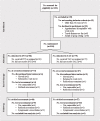One-year randomized controlled trial and follow-up of integrated neurocognitive therapy for schizophrenia outpatients
- PMID: 25713462
- PMCID: PMC4393700
- DOI: 10.1093/schbul/sbu223
One-year randomized controlled trial and follow-up of integrated neurocognitive therapy for schizophrenia outpatients
Abstract
Objective: Cognitive remediation (CR) approaches have demonstrated to be effective in improving cognitive functions in schizophrenia. However, there is a lack of integrated CR approaches that target multiple neuro- and social-cognitive domains with a special focus on the generalization of therapy effects to functional outcome.
Method: This 8-site randomized controlled trial evaluated the efficacy of a novel CR group therapy approach called integrated neurocognitive therapy (INT). INT includes well-defined exercises to improve all neuro- and social-cognitive domains as defined by the Measurement And Treatment Research to Improve Cognition in Schizophrenia (MATRICS) initiative by compensation and restitution. One hundred and fifty-six outpatients with a diagnosis of schizophrenia or schizoaffective disorder according to DSM-IV-TR or ICD-10 were randomly assigned to receive 15 weeks of INT or treatment as usual (TAU). INT patients received 30 bi-weekly therapy sessions. Each session lasted 90min. Mixed models were applied to assess changes in neurocognition, social cognition, symptoms, and functional outcome at post-treatment and at 9-month follow-up.
Results: In comparison to TAU, INT patients showed significant improvements in several neuro- and social-cognitive domains, negative symptoms, and functional outcome after therapy and at 9-month follow-up. Number-needed-to-treat analyses indicate that only 5 INT patients are necessary to produce durable and meaningful improvements in functional outcome.
Conclusions: Integrated interventions on neurocognition and social cognition have the potential to improve not only cognitive performance but also functional outcome. These findings are important as treatment guidelines for schizophrenia have criticized CR for its poor generalization effects.
© The Author 2015. Published by Oxford University Press on behalf of the Maryland Psychiatric Research Center. All rights reserved. For permissions, please email: journals.permissions@oup.com.
Figures
Comment in
-
Targeting social and non-social cognition to improve cognitive remediation outcomes in schizophrenia.Evid Based Ment Health. 2016 Feb;19(1):28. doi: 10.1136/eb-2015-102111. Epub 2016 Jan 10. Evid Based Ment Health. 2016. PMID: 26755717 Free PMC article. No abstract available.
Similar articles
-
Does Integrated Neurocognitive Therapy (INT) reduce severe negative symptoms in schizophrenia outpatients?Schizophr Res. 2017 Oct;188:92-97. doi: 10.1016/j.schres.2017.01.037. Epub 2017 Feb 6. Schizophr Res. 2017. PMID: 28185784 Clinical Trial.
-
Cognitive enhancement therapy for schizophrenia: effects of a 2-year randomized trial on cognition and behavior.Arch Gen Psychiatry. 2004 Sep;61(9):866-76. doi: 10.1001/archpsyc.61.9.866. Arch Gen Psychiatry. 2004. PMID: 15351765 Clinical Trial.
-
A randomized, controlled trial of Social Cognition and Interaction Training (SCIT) for outpatients with schizophrenia spectrum disorders.Br J Clin Psychol. 2014 Sep;53(3):281-98. doi: 10.1111/bjc.12044. Epub 2014 Jan 13. Br J Clin Psychol. 2014. PMID: 24417608 Clinical Trial.
-
Effectiveness of Integrated Neurocognitive Therapy on Cognitive Impairment and Functional Outcome for Schizophrenia Outpatients.Schizophr Res Treatment. 2018 Oct 21;2018:2360697. doi: 10.1155/2018/2360697. eCollection 2018. Schizophr Res Treatment. 2018. PMID: 30420918 Free PMC article. Review.
-
Current trends in the empirical study of cognitive remediation for schizophrenia.Can J Psychiatry. 2013 Jun;58(6):311-8. doi: 10.1177/070674371305800602. Can J Psychiatry. 2013. PMID: 23768258 Review.
Cited by
-
Feasibility and Efficacy of a Psychological Therapy for Patients With a Schizophrenic Psychosis in an Inpatient Setting: Study Protocol of a Randomized Switch Controlled Trial.Front Public Health. 2020 Aug 12;8:391. doi: 10.3389/fpubh.2020.00391. eCollection 2020. Front Public Health. 2020. PMID: 32903368 Free PMC article.
-
Processing of Spoken Emotions in Schizophrenia: Forensic and Non-forensic Patients Differ in Emotional Identification and Integration but Not in Selective Attention.Front Psychiatry. 2022 Mar 21;13:847455. doi: 10.3389/fpsyt.2022.847455. eCollection 2022. Front Psychiatry. 2022. PMID: 35386523 Free PMC article.
-
Factors influencing harmonized health data collection, sharing and linkage in Denmark and Switzerland: A systematic review.PLoS One. 2019 Dec 12;14(12):e0226015. doi: 10.1371/journal.pone.0226015. eCollection 2019. PLoS One. 2019. PMID: 31830124 Free PMC article.
-
Early interventions in risk groups for schizophrenia: what are we waiting for?NPJ Schizophr. 2016 Mar 9;2:16003. doi: 10.1038/npjschz.2016.3. eCollection 2016. NPJ Schizophr. 2016. PMID: 27336054 Free PMC article. Review.
-
Computerized cognitive and social cognition training in schizophrenia for impulsive aggression.Schizophr Res. 2023 Jun;256:117-125. doi: 10.1016/j.schres.2022.11.004. Epub 2022 Nov 21. Schizophr Res. 2023. PMID: 36424289 Free PMC article. Clinical Trial.
References
-
- Kopelowicz A, Liberman RP, Ventura J, Zarate R, Mintz J. Neurocognitive correlates of recovery from schizophrenia. Psychol Med. 2005;35:1165–1173. - PubMed
-
- Liberman RP, Kopelowicz A. Recovery from schizophrenia: a concept in search of research. Psychiatr Serv. 2005;56:735–742. - PubMed
-
- Shivashankar S, Telfer S, Arunagiriraj J, et al. Has the prevalence, clinical presentation and social functioning of schizophrenia changed over the last 25 years? Nithsdale schizophrenia survey revisited. Schizophr Res. 2013;146:349–356. - PubMed
Publication types
MeSH terms
LinkOut - more resources
Full Text Sources
Other Literature Sources
Medical


